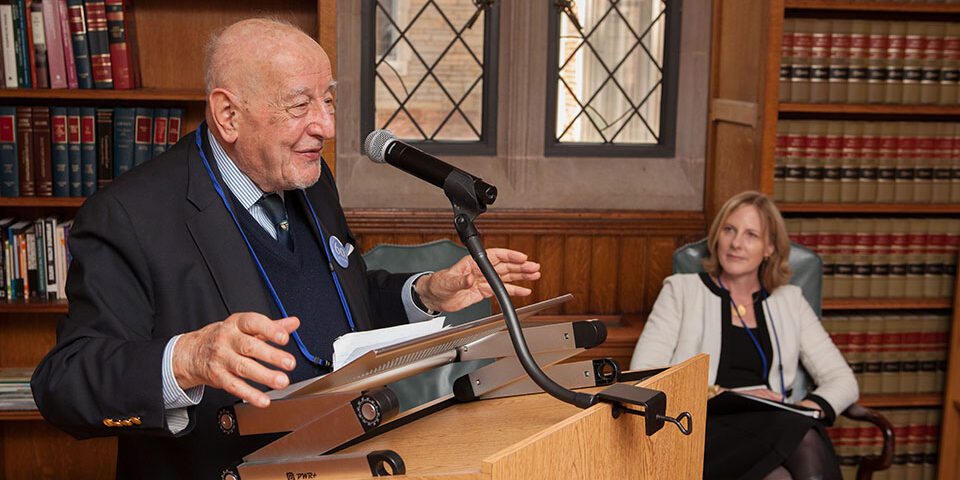Does Common Law Survive the “Age of Statutes”?
Is forty years too far along for a book review? Another look at A Common Law for the Age of Statutes by eminent Second Circuit Judge and Yale Law professor Guido Calabresi suggests no.
Published in 1982, the book originated in his 1977 delivery of the Oliver Wendell Holmes Lectures at Harvard Law School. If not the cure for what ails the Anglo-American legal tradition, it at least proposes one road out of the precarious place at which our system has arrived over the last century or so. Through Calabresi, more about him here, perhaps this reviewer can invite more discussion of both the common law’s problems and the need for solutions.
At the 2017 oral argument in Carpenter v. United States, Justice Neil Gorsuch asked questions of both counsel about the property status of information gathered and held by T-Mobile. Government agents had acquired “cell site location information” from the telecommunications provider without getting a warrant, and they used it to show that Mr. Carpenter had been in the locations where crimes occurred at the times they occurred. Carpenter objected to the warrantless seizure and the search of information detailing his whereabouts over long periods of time.
For Gorsuch, Carpenter’s Fourth Amendment claim might rise or fall on whether he had a property right in this data. “Say a thief broke into T-Mobile, stole this information, and sought to make economic value of it,” he asked Carpenter’s counsel. “Would your client have a conversion claim, for example, under state law? Have you explored that at all?”
As the Supreme Court moves haltingly away from the insipid “reasonable expectation of privacy” test, Gorsuch’s line of questioning seemed aimed at a textual approach to Fourth Amendment interpretation. The language of the amendment suggests asking the following questions: whether a seizure or search has occurred; whether the items seized or searched were persons, houses, papers, or effects; and then whether any such seizure or search was reasonable. Courts could use this more juridical approach to administer the Fourth Amendment even in high-tech cases.
The list of people’s items protected by the Fourth Amendment is modified by the possessive pronoun “their.” Thus, if Carpenter’s location data were his property, he would have a claim. If the data was not his, he would not.
The Age of Statutes
So how do property rights in information work? Is there a conversion action when data is stolen?
We are in the age of statutes. As a legal historian of arguable competence, I find that legislation, not common law, has addressed the chief threats to control of information against wrongful taking.
Consider proprietary business information. In 1972, commentators wrote in the Louisiana Law Review “that the law has evolved certain protections, based partially on tort concepts, partially on property concepts, substantially on contract concepts and vastly on equitable concepts, for a businessman’s secret information which allow him to conduct his business free from reprehensible business tactics.” That evolutionary process was overtaken by the Uniform Trade Secrets Act (USTA), now the primary state statute dealing with wrongful employee exfiltration of information, often known as “stealing.” The National Conference of Commissioners on Uniform State Laws adopted the USTA in 1979, after a process that began in 1968.
Hackers are the newer threat to information control. In the early days of the Internet, courts and commentators mulled common law solutions to new online wrongs, such as trespass to chattels, but those have been eclipsed by statutes such as the federal Computer Fraud and Abuse Act.
There are protections for personal information, of course, and of course they are statutory. One violates the U.S. Code by committing “identity theft.” That protects personal information against use in financial crimes. But people wanting to maintain privacy and security from more novel threats do not clearly enjoy the broader and more versatile protections of property rights.
Statutory protections like these form jetties, bridges, and floating walkways across the waters of risk. They do not replicate what Calabresi called in his book the legal “topography.”
Absent these statutes, the legal topography that might have emerged by now is a recognition of property rights in information (though not all of it). Information is routinely hoarded, traded, sold, subdivided, and used productively for pleasure or profit. These are sticks in the bundle that makeup property rights, as described by Tony Honoré and routinely taught to law students. When Carpenter contracted for services with T-Mobile, the contract gave possession and many use rights to the company, while Carpenter retained the all-important property right to exclude others from his data and thus protect his privacy.
With minor changes in emphasis, information squares with conventional theories of property, such as Locke’s mixing of labor. (Information over which people exercise dominion is owned. The rest is not.) Harold Demsetz’s “Toward a Theory of Property Rights” works for information as well. Property rights internalize positive and negative externalities to increase the wealth of information transactors and lower the costs they impose on others. In a paper I am working on, I argue that information is following the same course toward property rights treatment that real property did before recorded history, as tribes shifting from hunting and gathering to agriculture asserted property rights over the land they worked. Movables gained property rights protection at the end (and to hasten the end) of feudalism, driven by merchant guilds threatening to withhold (taxable) trade from kleptocratic lords.
When statute law provides the protections, though, common law development stops. The Uniform Trade Secrets Act provides the cause of action, so why would a litigant argue that there has been a conversion of a new form of common law property? When taking and using personal financial information in fraud violates a federal statute, why would prosecutors argue that common law property has been stolen or embezzled?
Courts do conceptualize information as property. Across 99 cases, the Supreme Court, every federal appellate court, and many state supreme courts have used the phrase, “stolen information,” to describe information as the object of property crime. (The phrase provides only a sampling of instances in which courts treat information as property, of course.) But with statutory compliance at issue, few courts have occasion to rule that information is common law property. The jetties and bridges created by statute law discourage the creation of further legal topography on which to walk.
A return to the common law process as bottom-up rule-making would do so much to strengthen our cherished legal inheritance.
Calabresi’s Common Law
My complaint is different from Calabresi’s. His chief aim in A Common Law for the Age of Statutes was to lament and begin to challenge where legislatures in their episodic—spasmodic—way deviate from legal topography that was formed over centuries. In another metaphor, they rip holes in the law’s “seamless web.” And he makes valuable points to support what today seems like a radical proposal.
The acts of legislatures spring from the momentary agreement of a majority of elected officials on a particular rule. From the next moment, the authority of that majority begins to fade. Its ability to reissue the rule is subject to substantial doubt, even more over time, so the moral authority of the rule falls away.
Common law courts, considered as a whole, act non-episodically. They accrete or abate legal rules over time—sometimes a very long time—which gives those rules as great or greater moral authority or legitimacy than statutes. Call it tradition, if you like, or inductive study. Common law development seems to be a better learning technique than hearings and markups populated by the rooms full of intellect you get in Washington, D.C., and state capitols. The selection process for common law rule development limits itself to where real disputes exist, while statute writers select their topics from inputs such as public attention, lobbying, and personal interest. Especially when they are unelected and tenured, judges almost never contemplate being on the other side of the “revolving door,” where many legislators, regulators, and their many staff end up.
Why have we decided that statutes should be the last word on what the law is when common law has the deeper reservoir of moral authority? Calabresi hasn’t, or didn’t.
Claiming intellectual league with James Landis, Justice Harlan Fiske Stone, California Supreme Court Chief Justice Roger Traynor, and others (listed in footnote 15 of chapter VIII), Calabresi argues that courts should be able to derogate from statutory law that renders the legal topography uneven. He does not believe that “statutorification” will go away and return common law courts to primacy, but “there will remain areas where courts can make law. Sometimes this will be in areas that have remained common law, and sometimes this will be in areas governed by statutes” (page 163). Modestly, Calabresi presents an idea that is audacious: reversing legislatures when their rules do not stand the test of time.
The conservative and libertarian legal movements have given a great deal of attention to statutory interpretation—and largely won the day through the force of Justice Antonin Scalia’s intellect and character. Even so, the merits of “original public meaning” textualism are under-sung. Giving expression to the actual agreement of those temporal legislative majorities, expressed in the language they used, is the only way not to usurp the democratic process!
But maybe we should usurp the democratic process. The popular theory of democracy does not line up with reality. Evidence of failure is coming in from many directions. Public choice economics has stripped away the romance to show that elected officials foremost seek power, not the common good. The collapse of limits on federal power and the distended administrative state have created a national system too large and complex for the public to oversee. The day-to-day practice of politics at the U.S. federal level especially seems to constantly plumb gaudy new lows of indecency and partisanship. Democracy’s merits seem to be disproven by the people “we” elect and the things they do with the power we give them. We can’t rely on politicians alone.
In “How to Recover Conservative Judging” here at Law & Liberty, Holden T. Tanner argues that the textual counter-reaction to “living constitutionalism” has not done enough to restore the prior status quo. “The moral and traditionalist reasoning of the common law method must be revived and validated. Even a better originalism is not enough. We need a holistic conservative jurisprudence.”
I worry that the argument is to imbue the law with a different somebody’s program, and it may pour more into the common law than it can hold. But a return to the common law process as bottom-up rule-making would do so much to strengthen our cherished legal inheritance. This age of statutes has stolen legal progress from us—and privacy, too, while information lacks common law characterization for use in Fourth Amendment cases. People are at too great risk when they travel our information spaces. Like early traders unprotected by property rights in movables, we are at risk from highwaymen and rapacious feudal lords alike. Clear rights to own and trade information would make us better off, but no statute says those rights exist. The statutes that do exist have taken courts off the path to that conclusion.
Judge Calabresi was right in 1982 to lament the “orgy of statute making” at which we have arrived. He sees statutes rending the fabric of the law and proposes to reassert the authority of the judiciary to say what the law is. My problem is different. I see new problems coming into existence, and a stunted common law failing to help solve them. I don’t think Judge Calabresi’s proposal to reverse errant statutes is ripe for adoption. How do we get a system that continues to develop the common law?


